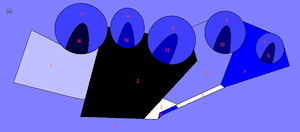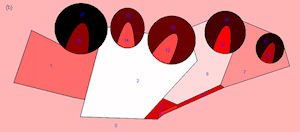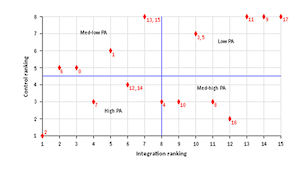PREVIOUS
NEXT
CONTENTS
HOME
4.3 Interpretation of assemblages and access
Until this point in the article I have been attempting to decide upon a suitable interpretation of the arrangement of structures at HP4. While I had set out hoping to make observations about one particular aspect of the HP4 site, it was necessary to study another aspect of it in order to continue with my original intentions for the article — it was not enough merely to suggest arrangements and test them in the hope that one would be correct. Barrett shares Russell's view that the multiple fencelines represent numerous phases of occupation, with the slight difference that he suggests "the eastward addition of buildings" (1994, 95). He also shares a view with Drewett — the idea that each hut had a specific occupant: "To enter one of these houses was perhaps to enter into the presence of those who stood at a particular genealogical relationship to the continuity of the community" (1994, 95). The similarities between the arrangement of fences at HP4 and that of sheep yards lead me to challenge the idea that the fences had a primarily social function, and to suggest that the reasons for their arrangement are predominantly practical, in order to allow control of livestock. The significant differences in artefact assemblages between the huts also suggest that they were not individual 'living units' but part of a larger whole. I am now able to state that my personal interpretation is that shown in Figures 6, 7a and 7b (the values obtained from gamma-analysis of this configuration are presented at the end of Quantifying Spaces). With this point clarified, observations can be made about the relationship between finds and access. A relationship between preservation and access has been discussed above.
While the finds at the hut platform reflect the event of abandonment and subsequent transformations, we should not necessarily take this to mean that they do not relate in any way to everyday life at the site. As such, the next section deals with the relationship between access and deposition. It should be noted that this new interpretation means that the codes for parts of the site used earlier in the study must now be abandoned, as new spaces can be clearly seen. For convenience, I have used the numbers given to the spaces in the new interpretation for the purposes of creating permeability maps for the remainder of the study.


Figure 7: (a) Image showing order of control values for the spaces in my new interpretation of HP4; (b) Image showing order of real relative asymmetry values for the spaces in my new interpretation of HP4. In both cases, darker shading indicates a higher value, lighter shading a lower value. It should be remembered that high control values represent spaces with strong control, whereas high RRA values represent spaces with a low level of integration into the system.
The orders of control and RRA values for this configuration can be plotted against one another on a graph to give a representation of the levels of 'presence availability' of — that is, the likelihood of social encounters taking place in — different spaces (see Putzeys et al. 2003). This is shown in Figure 8. The control ranking is obtained by listing the space numbers in order of the spaces' control values from highest (first) to lowest (eighth); the integration ranking is obtained by listing the space numbers in order of RRA values from lowest (first) to highest (fifteenth). Once the relative positions of each space in the two rankings has been plotted on a scatter graph, an indication of the presence availabilities of the spaces can be gleaned by dividing the plot area into quarters as seen in Figure 8. The existence of gates between spaces 1 and 7 would drastically alter the appearance of this graph. It was not possible to investigate this matter further in a study of this length but this could be the subject of a later study (see Grahame 1997, 150; for use of a similar method to analyse systems containing greater numbers of spaces, see Williams forthcoming). This allowed me to assign colours to the spaces of the new interpretation, as seen in Figure 9. I have included additional divisions between levels of presence availability on this image, as Space 2 has a significantly higher level of presence availability than other spaces in the 'High PA' section of the graph and Spaces 11, 9 and 17 have significantly lower levels than others in the 'Low PA' section.

Figure 8: Scatter graph plotting positions of each space in rankings of control values and integration (RRA) against one another.
With this image completed, it is possible to compare it directly with the plot of finds (Plotting Finds). A great number of observations can be made, and it is not possible to discuss them all in an article of this length. The exterior of the hut platform (Space 0) has a similar level of presence availability to Spaces 1, 6, 13 and 15. This reflects the fact that the hut platform was not something separate from the landscape in which it was set, but was instead directly related to it and was a part of it. This is also manifest in the evidence of artefacts, as a significant number of flint flakes and fire-cracked flint pieces, along with a diagnostic potsherd, were found outside the 'perimeter fence.' Another point that is easily noticeable from Figure 9 is that the dark areas of Huts 1, 4 and 5 have the lowest levels of presence availability on the site. While they are similar in this respect, they are much less alike when one considers their artefact assemblages; Hut 1 has a great variety of different types of find, while Hut 5 contains almost entirely flint in the form of flakes, fire-cracked pieces and two cores.
PREVIOUS
NEXT
CONTENTS
HOME
© Internet Archaeology/Author(s)
University of York legal statements | Terms and Conditions
| File last updated: Wed Dec 7 2011


